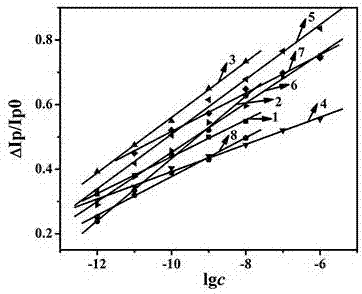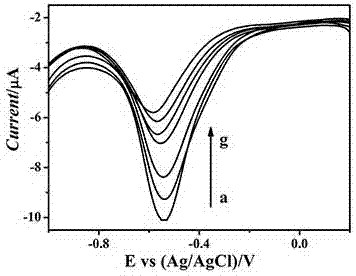A preparation method of an electrochemical sensor for detecting polycyclic aromatic hydrocarbons
A technology of polycyclic aromatic hydrocarbons and electrochemistry, which is applied in the direction of electrochemical variables of materials, can solve the problems of no electrochemical activity of polycyclic aromatic hydrocarbons and difficult detection of polycyclic aromatic hydrocarbons, and achieve simple and fast production process, increase movable space, and detection low limit effect
- Summary
- Abstract
- Description
- Claims
- Application Information
AI Technical Summary
Problems solved by technology
Method used
Image
Examples
Embodiment 1
[0029] Example 1 A preparation method of an electrochemical sensor for detecting polycyclic aromatic hydrocarbons
[0030] Step 1. Preparation of 2,6-diaminoanthraquinone (2,6-DA) functionalized graphene (GR): Weigh 0.2 g graphene oxide and dissolve in 85 mL SOCl 2 and 4 mL of dry DMF, refluxed at 70°C for 24 h with magnetic stirring to obtain a solid, dissolved the solid in 40 mL of dry DMF, added 0.2 g of 2,6-DA for ultrasonic treatment for 2 h, and added 12 drops of pyridine Stir mechanically at 85°C for 31 h, cool, filter, wash, and dry at 85°C to obtain 2,6-DA-GR as a solid.
[0031] Step 2. Prepare 2,6-DA-Grp / EDOT polymerization base solution; weigh 0.014 g of EDOT solution and 0.039 g of barium perchlorate in 10 mL of acetonitrile and DMF solution with a volume ratio of 1:1, and then add The 2,6-DA-GR prepared in step (1) was ultrasonically treated for 10 min, and then passed through high-purity nitrogen for 15 min to obtain a uniformly dispersed polymerization bottom ...
PUM
 Login to View More
Login to View More Abstract
Description
Claims
Application Information
 Login to View More
Login to View More - R&D
- Intellectual Property
- Life Sciences
- Materials
- Tech Scout
- Unparalleled Data Quality
- Higher Quality Content
- 60% Fewer Hallucinations
Browse by: Latest US Patents, China's latest patents, Technical Efficacy Thesaurus, Application Domain, Technology Topic, Popular Technical Reports.
© 2025 PatSnap. All rights reserved.Legal|Privacy policy|Modern Slavery Act Transparency Statement|Sitemap|About US| Contact US: help@patsnap.com



